The Wakarusa War
Tour Stop
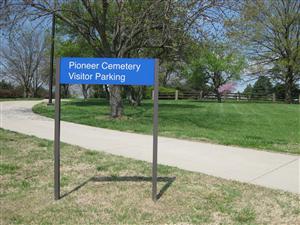
Directions: A memorial [ Waypoint = N38 57.171 W95 15.729 ] to Thomas Barber, free-state martyr killed in 1855 during the Wakarusa War, is located in the Pioneer Cemetery. The entrance to Pioneer Cemetery [ Waypoint = N38 57.148 W95 15.752 ] is located across from the Lied Center on the University of Kansas campus in Lawrence, Kansas 66045.
- From Oak Hill Cemetery, get headed south on Elmwood Street.
- After 0.1 miles, turn right (west) onto E 15th Street.
- After 0.4 miles, turn left (south) onto Haskell Avenue.
- After 0.5 miles, turn right (west) onto E 19th Street.
- After about 2 miles, cross Iowa Street (traffic light) and then turn right (north) onto Constant Avenue.
- The Pioneer Cemetery parking area [ Waypoint = N38 57.106 W95 15.719 ] is about 0.2 miles ahead on the right.
- Walk up Constant Avenue to the west entrance to the cemetery.
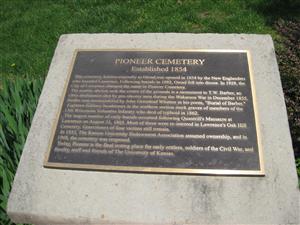
Description: The Pioneer Cemetery marker's text reads as follows:
Pioneer Cemetery
Established 1854
This Cemetery, known originally as Oread, was opened in 1854 by the New Englanders who founded Lawrence. Following burials in 1882, Oread fell into disuse. In 1928, the City of Lawrence changed the name to Pioneer Cemetery.
The marble obelisk near the center of the grounds is a monument to T. W. Barber, an Ohio abolitionist shot by pro-slavery men during the Wakarusa War in December 1855. Barber was memorialized by John Greenleaf Whittier in his poem, "Burial of Barber." Eighteen military headstones in the northern section mark graves of members of the 13th Wisconsin Volunteer Infantry who died of typhoid in 1862.
The largest number of early burials occurred following Quantrill's Massacre at Lawrence on August 21, 1863. Most of these were re-interred in Lawrence's Oak Hill Cemetery. Gravestones of four victims still remain.
In 1953, The Kansas University Endowment Association assumed ownership, and in 1968, the cemetery was reopened.
Today, Pioneer is the final resting place for early settlers, soldiers of the Civil War, and faculty, staff and friends of The University of Kansas.
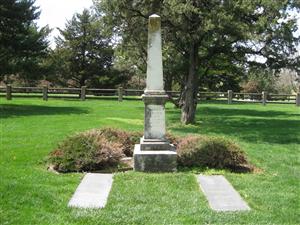
You are standing at the place where Thomas Barber, the only fatality during the Wakarusa War, was buried in December of 1855. On December 6th, 1855, while Lawrence was still under siege by a pro-slavery militia, Thomas Barber and two other free-state settlers left Lawrence to return to their homes. Along the way they were intercepted by a pro-slavery patrol. The free-state settlers refused to go with the Missourians. Shots were fired by both sides and Thomas Barber was mortally wounded. Word of Barber's death quickly spread and this greatly increased the tensions between the besieged defenders in Lawrence and the Missourians along the Wakarusa River.
The Wakarusa War started over a claim dispute in northeastern Kansas. In the free state settlement of Hickory Point, Franklin M. Coleman was squatting on land whose claim was sold to Jacob Branson, who had emigrated from Indiana. Late in 1854, Branson attempted to evict Coleman from his claim. After arbitration, Branson and Coleman each were awarded part of the claim, but the boundaries were left unclear. Branson invited others, including a Charles W. Dow, to settle on the claim. The difficulties between Branson and Coleman continued with Branson trying to intimidate Coleman into leaving. On November 21, 1855, there was an altercation between Coleman and Dow during which Coleman shot and killed Dow. Coleman subsequently fled to Missouri.
On November 26th, some free staters met at Branson's house and planned retaliation against pro-slavery supporters. Coleman's house was burned down. Soon, Samuel J. Jones, the sheriff of Douglas County, showed up with a posse and arrested Branson for disturbing the peace. As Jones and his posse were leaving Hickory Point, a large group of armed free staters blocked their path and demanded the release of Branson. Although he had a warrant for Branson's arrest, Sheriff Jones decided not to escalate to violence and released Branson. Branson was hurried off to Lawrence and safety.
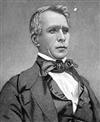 Jones reported to Kansas Territorial Governor Wilson Shannon that a prisoner had been taken from his custody by a large body of armed men. Shannon issued a call for the territorial militia. Much to Shannon's dismay, men from Missouri answered his call. Sheriff Jones was in charge of about 2,000 Missourians camped near Lawrence, Kansas on the Wakarusa River. The free staters in Lawrence sent out calls for assistance to help defend Lawrence against the Missourians. They began to build fortifications and entrenchments in Lawrence to prepare for its defense. The residents of Lawrence were dismayed by this turn of events and Branson was encouraged to leave Lawrence, which he did.
Jones reported to Kansas Territorial Governor Wilson Shannon that a prisoner had been taken from his custody by a large body of armed men. Shannon issued a call for the territorial militia. Much to Shannon's dismay, men from Missouri answered his call. Sheriff Jones was in charge of about 2,000 Missourians camped near Lawrence, Kansas on the Wakarusa River. The free staters in Lawrence sent out calls for assistance to help defend Lawrence against the Missourians. They began to build fortifications and entrenchments in Lawrence to prepare for its defense. The residents of Lawrence were dismayed by this turn of events and Branson was encouraged to leave Lawrence, which he did.
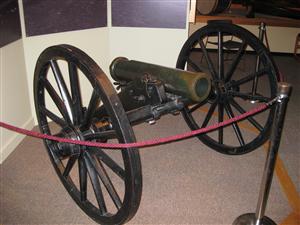 Although James H. Lane had taken a leadership role in preparing for the defense of Lawrence, free state leaders were very interested in finding a peaceful resolution to the current crisis. While Lane drilled the defenders, they began discussions with Governor Shannon and President Franklin Pierce. Meanwhile, the Missourians had laid siege to Lawrence and were trying to prevent any kind of assistance from arriving. But free staters were able to get some munitions through this blockade, including a howtizer smuggled in from Kansas City, Missouri.
Although James H. Lane had taken a leadership role in preparing for the defense of Lawrence, free state leaders were very interested in finding a peaceful resolution to the current crisis. While Lane drilled the defenders, they began discussions with Governor Shannon and President Franklin Pierce. Meanwhile, the Missourians had laid siege to Lawrence and were trying to prevent any kind of assistance from arriving. But free staters were able to get some munitions through this blockade, including a howtizer smuggled in from Kansas City, Missouri.
On December 6th, three free state settlers left Lawrence and were returning to their homes. They were intercepted by a pro-slavery patrol. But they refused to go with the Missourians. Shot were fired by both sides and one of the free state settlers, Thomas Barber, had been mortally wounded. Word of Barber's death quickly spread. This greatly increased the tension that existed between the besieged defenders in Lawrence and the Missourians along the Wakarusa River.
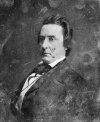
 Governor Shannon enlisted the aid of Colonel Albert Boone, the grandson of Daniel Boone. They first talked with the pro-slavery leaders and then entered Lawrence to talk with the free state leaders. As the negotiations continued, Shannon was able to prevent a planned attack on Lawrence by the Missourians. On December 8th, there were extensive discussions. Missouri Senator David Atchison and Colonel Albert Boone represented the interests of the pro-slavery supporters and James Lane and Charles Robinson represented the interests of the free state supporters. After five hours of discussion, both sides signed a written agreement ending the crisis. Governor Shannon ordered the militia to disband.
Governor Shannon enlisted the aid of Colonel Albert Boone, the grandson of Daniel Boone. They first talked with the pro-slavery leaders and then entered Lawrence to talk with the free state leaders. As the negotiations continued, Shannon was able to prevent a planned attack on Lawrence by the Missourians. On December 8th, there were extensive discussions. Missouri Senator David Atchison and Colonel Albert Boone represented the interests of the pro-slavery supporters and James Lane and Charles Robinson represented the interests of the free state supporters. After five hours of discussion, both sides signed a written agreement ending the crisis. Governor Shannon ordered the militia to disband.
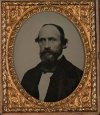 But they were not out of the woods yet. Lane and Robinson feared the Missourians would resort to violence after being disbanded by their leaders. Governor Shannon agreed.
But they were not out of the woods yet. Lane and Robinson feared the Missourians would resort to violence after being disbanded by their leaders. Governor Shannon agreed.
Senator Atchison did not want violence to bring bad press to the pro-slavery movement and worked hard to put a stop to any violence before it happened. A it turned out, he was able to get the Missourians to return home with minimal problems.
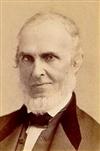 But Shannon acted anyway, giving approval to plans by Lane and Robinson to raise a militia for the purpose of repelling invaders. Now the free staters had legitimized their, up-to-now, illegal military force. The free-state cause also had a martyr. The abolitionist, John Greenleaf Whittier, wrote a poem he called “Burial of Barber”.
But Shannon acted anyway, giving approval to plans by Lane and Robinson to raise a militia for the purpose of repelling invaders. Now the free staters had legitimized their, up-to-now, illegal military force. The free-state cause also had a martyr. The abolitionist, John Greenleaf Whittier, wrote a poem he called “Burial of Barber”.
